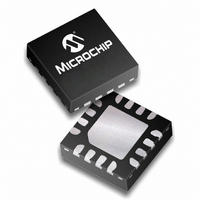PIC16F688-E/ML Microchip Technology, PIC16F688-E/ML Datasheet - Page 516

PIC16F688-E/ML
Manufacturer Part Number
PIC16F688-E/ML
Description
IC PIC MCU FLASH 4KX14 16QFN
Manufacturer
Microchip Technology
Series
PIC® 16Fr
Datasheets
1.PIC16F616T-ISL.pdf
(8 pages)
2.PIC16F688T-ISL.pdf
(204 pages)
3.PIC16F688T-ISL.pdf
(6 pages)
4.PIC16F688T-ISL.pdf
(4 pages)
5.PIC16F688T-ISL.pdf
(688 pages)
Specifications of PIC16F688-E/ML
Core Size
8-Bit
Program Memory Size
7KB (4K x 14)
Core Processor
PIC
Speed
20MHz
Connectivity
UART/USART
Peripherals
Brown-out Detect/Reset, POR, WDT
Number Of I /o
12
Program Memory Type
FLASH
Eeprom Size
256 x 8
Ram Size
256 x 8
Voltage - Supply (vcc/vdd)
2 V ~ 5.5 V
Data Converters
A/D 8x10b
Oscillator Type
Internal
Operating Temperature
-40°C ~ 125°C
Package / Case
16-QFN
Controller Family/series
PIC16F
No. Of I/o's
12
Eeprom Memory Size
256Byte
Ram Memory Size
256Byte
Cpu Speed
20MHz
No. Of Timers
2
Processor Series
PIC16F
Core
PIC
Data Bus Width
8 bit
Data Ram Size
256 B
Interface Type
EUSART, RS- 232, SCI, USB
Maximum Clock Frequency
20 MHz
Number Of Programmable I/os
12
Number Of Timers
2
Maximum Operating Temperature
+ 125 C
Mounting Style
SMD/SMT
3rd Party Development Tools
52715-96, 52716-328, 52717-734
Development Tools By Supplier
PG164130, DV164035, DV244005, DV164005, PG164120, ICE2000, DM163014, DM164120-4
Minimum Operating Temperature
- 40 C
On-chip Adc
10 bit, 8 Channel
Lead Free Status / RoHS Status
Lead free / RoHS Compliant
For Use With
AC164324 - MODULE SKT FOR MPLAB 8DFN/16QFNXLT16QFN1 - SOCKET TRANSITION 14DIP TO 16QFNAC162061 - HEADER INTRFC MPLAB ICD2 20PINAC162056 - HEADER INTERFACE ICD2 16F688
Lead Free Status / Rohs Status
Details
- PIC16F616T-ISL PDF datasheet
- PIC16F688T-ISL PDF datasheet #2
- PIC16F688T-ISL PDF datasheet #3
- PIC16F688T-ISL PDF datasheet #4
- PIC16F688T-ISL PDF datasheet #5
- Current page: 516 of 688
- Download datasheet (3Mb)
PICmicro MID-RANGE MCU FAMILY
28.7
DS31028A-page 28-8
Field Programming of PICmicro OTP MCUs
An OTP device is not normally capable of being reprogrammed, but the PICmicro architecture
gives you this flexibility provided the size of your firmware is at least half that of the desired device
and the device is not code protected. If your target device does not have enough program mem-
ory, Microchip provides a wide spectrum of devices from 0.5K to 8K program memory with the
same set of peripheral features that will help meet the criteria.
The PIC16CXXX microcontrollers have two vectors, reset and interrupt, at locations 0x0000 and
0x0004. When the PICmicro encounters a reset or interrupt condition, the code located at one of
these two locations in program memory is executed. The first listing of
code that is first programmed into the PICmicro. The second listing of
code that is programmed into the PICmicro for the second time.
Example 28-2
originally goto Main (0x2808), is reprogrammed to all 0’s which happens to be a NOP instruction.
This location cannot be reprogrammed to the new opcode (0x2860) because the bits that are 0’s
cannot be reprogrammed to 1’s, only bits that are 1’s can be reprogrammed to 0’s. The next mem-
ory location 0x0001 was originally blank (all 1’s) and now becomes a goto Main (0x2860). When
a reset condition occurs, the PICmicro executes the instruction at location 0x0000 which is the
NOP , a completely benign instruction, and then executes the goto Main to start the execution of
code. The example also shows that all program memory locations after 0x005A are blank in the
original program so that the second time the PICmicro is programmed, the revised code can be
programmed at these locations. The same descriptions can be given for the interrupt vector at
location 0x0004.
This method changes slightly for PICmicros with >2K words of program memory. Each of the
goto
Example 28-1
Example 28-1:
Now your one-time programmable PICmicro is exhibiting EEPROM- or Flash-like qualities.
movlw <page>
movwf PCLATH
goto
Main and goto
Main
shows that to program the PICmicro a second time the memory location 0x0000,
due to paging on devices with >2K words of program memory.
Crossing Program Memory Pages
ISR instructions are replaced by the following code segment is
movlw <page>
movwf PCLATH
goto
ISR
1997 Microchip Technology Inc.
Example 28-2
Example 28-2
shows the
shows the
Related parts for PIC16F688-E/ML
Image
Part Number
Description
Manufacturer
Datasheet
Request
R

Part Number:
Description:
Manufacturer:
Microchip Technology Inc.
Datasheet:

Part Number:
Description:
IC PIC MCU FLASH 4KX14 14SOIC
Manufacturer:
Microchip Technology
Datasheet:

Part Number:
Description:
IC MCU FLASH 4KX14 14TSSOP
Manufacturer:
Microchip Technology
Datasheet:

Part Number:
Description:
IC PIC MCU FLASH 4KX14 14DIP
Manufacturer:
Microchip Technology
Datasheet:

Part Number:
Description:
IC PIC MCU FLASH 4KX14 16QFN
Manufacturer:
Microchip Technology
Datasheet:

Part Number:
Description:
IC MCU PIC FLASH 4KX14 14SOIC
Manufacturer:
Microchip Technology
Datasheet:

Part Number:
Description:
IC PIC MCU FLASH 4KX14 14TSSOP
Manufacturer:
Microchip Technology
Datasheet:

Part Number:
Description:
IC MCU PIC FLASH 4KX14 14DIP
Manufacturer:
Microchip Technology
Datasheet:

Part Number:
Description:
IC PIC MCU FLASH 4KX14 14TSSOP
Manufacturer:
Microchip Technology
Datasheet:

Part Number:
Description:
IC, 8BIT MCU, PIC16F, 32MHZ, SOIC-18
Manufacturer:
Microchip Technology
Datasheet:

Part Number:
Description:
IC, 8BIT MCU, PIC16F, 32MHZ, SSOP-20
Manufacturer:
Microchip Technology
Datasheet:

Part Number:
Description:
IC, 8BIT MCU, PIC16F, 32MHZ, DIP-18
Manufacturer:
Microchip Technology
Datasheet:

Part Number:
Description:
IC, 8BIT MCU, PIC16F, 32MHZ, QFN-28
Manufacturer:
Microchip Technology
Datasheet:

Part Number:
Description:
IC, 8BIT MCU, PIC16F, 32MHZ, QFN-28
Manufacturer:
Microchip Technology
Datasheet:

Part Number:
Description:
IC, 8BIT MCU, PIC16F, 32MHZ, QFN-28
Manufacturer:
Microchip Technology
Datasheet:










